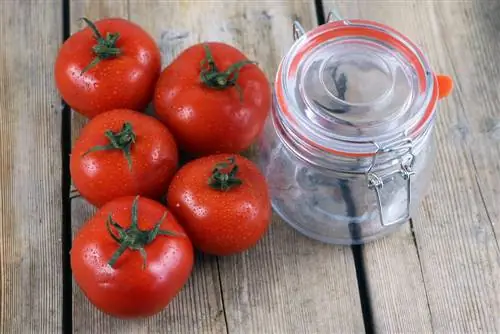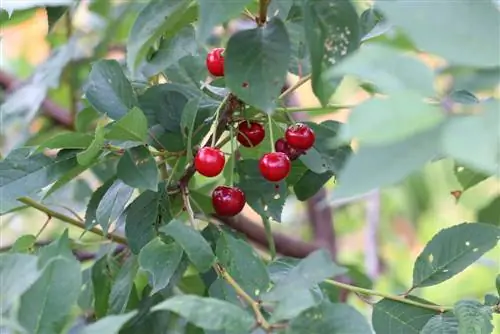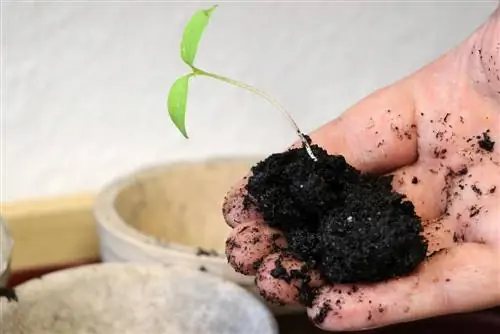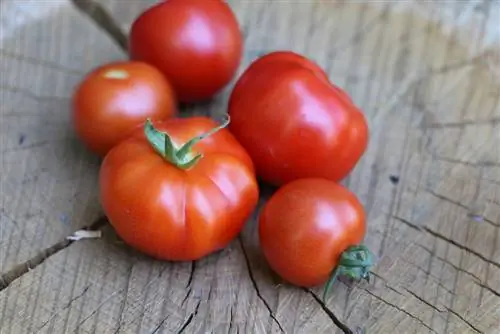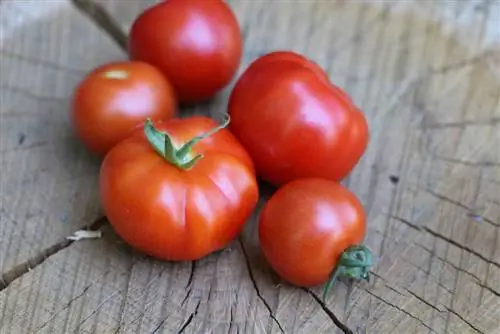- Author admin [email protected].
- Public 2023-12-17 03:39.
- Last modified 2025-01-24 12:45.
Cocktail tomatoes are easy to grow and care for. They are particularly suitable for balconies. You can plant them normally in planters, but there are also varieties that are suitable for normal balcony boxes and as hanging basket plants. Cocktail tomatoes are the smallest tomatoes, also called baby, party, cherry, mini or cherry tomatoes. Because these varieties are so popular, the range has expanded quite a bit in recent years. The sweet fruits are very trendy. Their popularity can be explained by their high sugar content and the resulting sweetness of the fruits. However, the yields are usually slightly lower than with other varieties.
Cocktail tomatoes are popular garden and balcony plants not only because of their taste, but also because they are easy to grow. Especially on balconies, cocktail tomatoes can be planted in pots or balcony boxes as well as in hanging baskets. Cocktail tomatoes are the smallest tomatoes. They are also called cherry, mini, party, baby or cherry tomatoes. There are different varieties such as the Golden Currant, the Lollipop, Goldita, Mirabell or Yellow Pearshaped.
Sowing and planting cocktail tomatoes
Cocktail tomatoes are sown between February and April, depending on the weather. The plants germinate after five to ten days. When the first cotyledons appear, the plants should be pricked out. When pricking out, the small seedlings are transferred to small pots. These pots are still in heated indoor spaces or in greenhouses. The grown tomato plants can also be purchased from specialist retailers. In May, when the frost has passed, the small tomato plants are planted outdoors. The tomatoes are always planted after the Ice Saints have passed. It is important that the plants are placed in a sunny and wind-protected place. You should also make sure that no potatoes are planted near the tomatoes, as the cocktail tomatoes can get diseases such as brown rot. However, the most important thing when planting is to choose a sunny place that is protected from wind and rain. In the garden, south-facing walls are ideal for growing cocktail tomatoes. Sunlight is reflected here, which provides additional warmth. To protect the sensitive cocktail tomatoes from rain, they should be covered with a tarpaulin in wet weather. However, this tarp should not touch the tomatoes themselves. This protection should only be installed when it is actually raining. The tarpaulin should then be quickly removed again. If covering is not possible or if it seems too laborious, you should build a roof.
There are ready-made tomato houses in various sizes in specialist stores. These have two walls and a roof. Such protection does not need to be additionally installed on covered balconies. However, the plants here need large containers so that the tomatoes can develop optimally. The buckets should contain at least four liters so that the cocktail tomatoes can thrive optimally. If the tomatoes are planted, a fairly deep planting hole must be dug. This planting hole is now filled with fertilized soil or nutrient-rich humus. As a guideline, there should be a distance of around 5 cm between the ground and the first leaves. This also applies to potted plants on the balcony. Here the plants are to be placed individually in the pots. On the balcony or in the garden, a stick or straight rod is placed in the ground as a climbing aid. The plant is attached to this at regular intervals. A distance of around 30 to 50 cm should be left between the perennials in the bed. Immediately after the perennials are planted, they must be watered well.
Preventing brown rot on tomato bushes
Brown rot is a common disease of tomato plants that is caused by a fungus. This mushroom feels most comfortable in a warm, humid climate. The disease can first be recognized in the plant by the black-brown coloring on the leaves. Only when the disease is very advanced do the fruits show brown spots. In addition, under the right conditions, a light fungal fuzz forms on the tomatoes. If a plant is affected by brown rot, the fruits can only be thrown away. They are not suitable for consumption.
Pruning out tomato plants
Unlike other types of tomatoes, cocktail tomatoes do not necessarily have to be used. However, thinning is recommended if you value beautiful, large fruits. The thinning method means that the entire power of the plant can be put into the fruits. In order for this to happen, the side shoots are regularly removed when thinning out. The plant, which no longer needs energy for the side shoots, can put its energy into the fruits, which become larger and have a more intense taste. Thinning out promotes upward growth. To achieve this, climbing aids such as bamboo poles are essential. Specialist retailers offer tomato spiral sticks specially made for this purpose, around which tomatoes can easily wrap. This is the only way the plants can bear the heavy fruit. Without thinning and attaching to the trellises, the tomatoes grow bushy to the side or lean towards the ground.
Caring for tomato bushes
Tomatoes, which themselves consist mainly of water, require a lot of water during the growth phase. However, when watering, make sure that the leaves and fruits of the plants are not wetted with water. If the leaves or fruits become wet, this moisture provides an optimal breeding ground for diseases such as late blight or brown rot. If the diseases first manifest themselves in the plant, this can mean that it dies completely. Such diseases spread particularly quickly in rainy summers, when the plant is constantly exposed to moisture, which is why it is important to ensure that suitable protection against moisture is provided. The plant must be harvested at the end of summer before the rainy autumn sets in. Even if the tomatoes are still green, they should be removed. The fruits ripen within a few days, even if they have already been harvested.
Care tips for cocktail tomatoes
- water abundantly, but not on the leaves
- fertilize with a tomato fertilizer or compost
- Provide protection from rain
Many cocktail tomato plants tend to grow tall (over two meters) and with multiple shoots. They are well suited as espalier plants. You can usually harvest the first fruits from the beginning of August. The yield is usually good to very good. Some fruits can be harvested until the first frost.
Growing tomatoes
In cultivation, cocktail tomatoes are no different from other varieties. The only difference is that cocktail tomatoes are usually not used to their full potential. The bushy growth is desirable for them. This is the only way to get the amount of small fruits. Otherwise, treat them like other tomato plants. They need plenty of water and nutrients and must not get wet. A sunny, warm and sheltered location is ideal.
Cocktail tomatoes are therefore very suitable for a covered balcony or terrace, where they stay dry even when it rains. If you want to grow them in the garden, it makes sense to put them in a tomato or greenhouse. However, a few plants can also be protected with a fleece. This fleece also provides the necessary warmth so that the tomatoes can ripen well. Nevertheless, you should wait until mid-May before planting the tomatoes because they are sensitive to frost. Unlike the climbing tomato varieties, which grow very tall, the bushy vine tomatoes require a little more space in width. However, this depends on the variety.
Caring for cocktail tomatoes
In order for many tomatoes to form, the plants need a lot of water while growing. However, the leaves should under no circumstances be moistened when watering, as this will quickly cause the plants to become sick. Late blight is a big problem, especially in rainy summers, and can easily lead to the complete death of plants. It spreads very quickly if the leaves of the tomatoes are constantly wet. A location where the wind dries the leaves quickly offers a certain degree of protection if there is no other option for growing the tomatoes under a roof. A tomato fertilizer or, for specimens planted in the garden, some compost also ensures a rich harvest. At the end of summer, all fruits can be harvested, even if they are still green at that time. Tomatoes continue to ripen even after harvest because they produce the gas ethylene necessary for ripening.
Varieties & Species
Idyll is a good variety. It is one of the most productive and aromatic cocktail tomatoes. The small, 20 to 25 mm large, aromatic, slightly sweet fruits ripen very early and produce surprisingly high yields. As a stick tomato, Idyll produces bunches up to 30 cm long with a lot of fruit per bunch. The plants are well suited for balconies and terraces.


